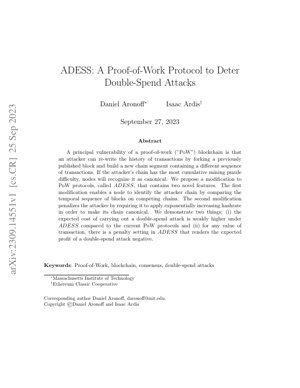Table of Contents
1 Introduction
The fundamental vulnerability in proof-of-work (PoW) blockchains lies in the ability of attackers to rewrite transaction history by forking previously published blocks and building alternative chain segments with different transaction sequences. When the attacker's chain accumulates more mining puzzle difficulty than the incumbent canonical chain, nodes are compelled to recognize it as legitimate. This vulnerability enables double-spend attacks, where attackers can negate token transfers recorded on the original chain.
Attack Instances
Multiple
Double-spend attacks on Ethereum Classic and Bitcoin Gold (2018-2020)
Security Improvement
Exponential
Cost increase for successful attacks
1.1 The two ADESS modifications
ADESS introduces two critical modifications to existing PoW protocols. The first modification enables identification of attacker chains by analyzing temporal block sequences. The second imposes exponential penalties on identified attackers, significantly increasing the computational cost required to make forked chains canonical.
2 Technical Framework
2.1 Attacker Chain Identification
The identification mechanism leverages the behavioral pattern of double-spend attackers. When Bob receives tokens from Alice, he waits for transaction confirmation through multiple blocks before delivering goods or services. Meanwhile, Alice secretly builds an alternative chain but delays broadcasting it until after receiving Bob's exchange item. ADESS uses this broadcast delay pattern to identify potential attacker chains.
2.2 Exponential Penalty Mechanism
Once an attacker chain is identified, ADESS applies exponential penalties that require the attacker to apply increasingly higher hashrate to make their chain canonical. The penalty grows with the depth of the fork, making sustained attacks economically infeasible.
3 Mathematical Formulation
The ADESS protocol introduces a penalty function $P(d) = \alpha \cdot \beta^d$ where:
- $P(d)$ represents the penalty at fork depth $d$
- $\alpha$ is the base penalty multiplier
- $\beta$ is the exponential growth factor ($\beta > 1$)
- $d$ is the number of blocks since the fork point
The effective mining difficulty for the attacker becomes $D_{eff} = D \cdot P(d)$, where $D$ is the nominal mining difficulty.
4 Experimental Results
The researchers demonstrated two key results through simulation and mathematical analysis:
- The expected cost of double-spend attacks is weakly higher under ADESS compared to traditional PoW protocols
- For any transaction value, there exists a penalty setting that renders the expected profit of double-spend attacks negative
Key Insights
- ADESS effectively raises attack costs without compromising network performance
- The protocol works best with frequent difficulty adjustments
- No additional oracles or external trust assumptions required
5 Code Implementation
Below is a simplified pseudocode implementation of the ADESS chain selection algorithm:
function selectCanonicalChain(chains):
// Find common ancestor block
common_ancestor = findCommonAncestor(chains)
// Identify potential attacker chains based on broadcast timing
potential_attackers = identifyLateBroadcastChains(chains, common_ancestor)
// Apply exponential penalties to identified chains
for chain in chains:
if chain in potential_attackers:
fork_depth = current_block_height - common_ancestor.height
penalty = base_penalty * (growth_factor ^ fork_depth)
chain.score = calculateCumulativeDifficulty(chain) / penalty
else:
chain.score = calculateCumulativeDifficulty(chain)
// Select chain with highest adjusted score
return chain with maximum score
6 Analysis and Discussion
The ADESS protocol represents a significant advancement in PoW blockchain security by addressing the fundamental double-spend vulnerability that has plagued cryptocurrencies since Bitcoin's inception. Unlike traditional approaches that rely solely on cumulative difficulty, ADESS introduces temporal analysis of block sequences, creating a more nuanced security model. This approach aligns with recent research in blockchain security, such as the work by Gervais et al. (2016) on quantifying the decentralization of consensus protocols, which emphasizes the importance of incorporating multiple security dimensions.
The exponential penalty mechanism in ADESS is particularly innovative because it creates a dynamically adjusting defense system. As noted in the Bitcoin White Paper (Nakamoto, 2008), the security of proof-of-work systems depends on honest nodes controlling majority CPU power. ADESS strengthens this principle by making it exponentially more difficult for attackers to maintain fraudulent chains over time. This approach shares conceptual similarities with Ethereum's difficulty bomb mechanism but applies it specifically to attack deterrence rather than protocol upgrades.
Compared to other double-spend prevention mechanisms like Checkpointing (used in Bitcoin Cash) or Avalanche consensus (as described in the Avalanche White Paper), ADESS maintains the permissionless nature of traditional PoW while adding sophisticated attack detection. The protocol's effectiveness in simulations suggests it could have prevented real-world attacks like the 2019 Ethereum Classic double-spends, which according to the MIT Digital Currency Initiative resulted in millions of dollars in losses.
From an implementation perspective, ADESS demonstrates how subtle protocol modifications can yield substantial security improvements without requiring fundamental architectural changes. This approach contrasts with more radical departures like Proof-of-Stake (as implemented in Ethereum 2.0) or Directed Acyclic Graph (DAG) structures (as used in IOTA), showing that incremental evolution of existing protocols remains a viable path for blockchain security enhancement.
7 Future Applications
The ADESS protocol has promising applications beyond cryptocurrency security:
- Enterprise Blockchain: Enhanced security for supply chain and financial applications
- Cross-chain Bridges: Improved security for interoperability protocols
- Decentralized Finance: Additional protection for high-value DeFi transactions
- IoT Networks: Secure device coordination in distributed IoT systems
Future research directions include:
- Integration with sharded blockchain architectures
- Adaptation for proof-of-stake consensus mechanisms
- Machine learning enhancements for attack pattern detection
- Formal verification of security guarantees
8 References
- Nakamoto, S. (2008). Bitcoin: A Peer-to-Peer Electronic Cash System
- Wood, G. (2021). Ethereum: A Secure Decentralized Generalized Transaction Ledger
- Gervais, A., et al. (2016). On the Security and Performance of Proof of Work Blockchains
- Rocket, T., et al. (2020). Avalanche: A Novel Consensus Protocol
- MIT Digital Currency Initiative (2020). 51% Reorg Tracker
- Lovejoy, J. (2021). Ethereum Classic 51% Attacks: Technical Post-Mortem
- Singer, A. (2019). Analysis of Double-Spend Attacks on Ethereum Classic
